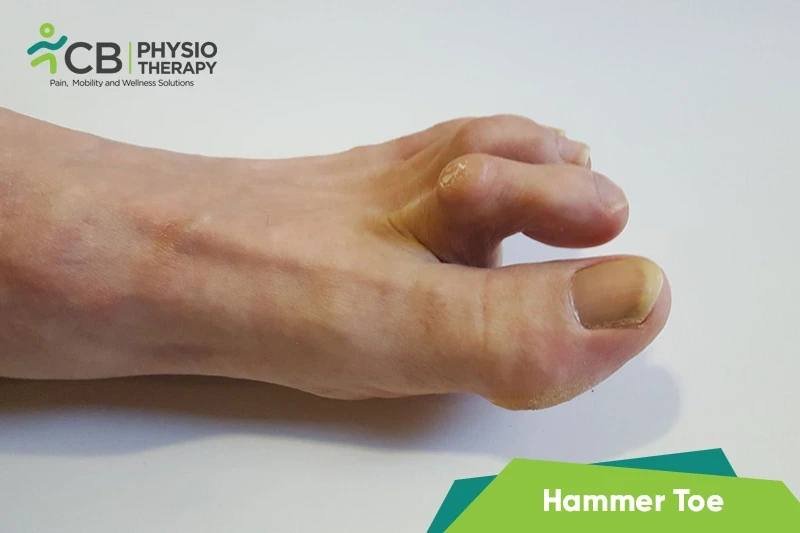
पुरुषों की तुलना में महिलाओं में हैमर टो विकसित होने की संभावना अधिक होती है, इसके अन्य कारण हो सकते हैं:
<उल शैली = "सूची-शैली-प्रकार: डिस्क;">
मुड़ने की डिग्री के आधार पर लक्षण भिन्न हो सकते हैं। आमतौर पर पाए जाने वाले लक्षण हैं:
<उल शैली = "सूची-शैली-प्रकार: डिस्क;">
पैथोलॉजी:
हैमर टो आंतरिक बलों से पैर की उंगलियों के लचीलेपन और विस्तार बल के बीच एक पुराना, निरंतर असंतुलन है, बाहरी ताकतें, या दोनों। हैमरटो विकृति में एमटीपी और डीआईपी जोड़ों के हाइपरेक्स्टेंशन के साथ पैर की अंगुली के पीआईपी जोड़ की फ्लेक्सन विकृति शामिल है।
शारीरिक परीक्षा:
परीक्षक पैर और पैर की अंगुली को धीरे-धीरे हिलाकर पैर की अंगुली की जांच करता है ताकि लक्षण उत्पन्न हो सकें। यह परीक्षक को पैर की अंगुली की स्थिति का पूरी तरह से मूल्यांकन करने में मदद करता है।
एक्स-रे
पैरों और पैर की उंगलियों की हड्डी और जोड़ों की जांच के लिए एक्स-रे किया जाता है
दवा: NSAIDs, कॉर्टिकोस्टेरॉइड इंजेक्शन, आदि।
ध्यान दें: डॉक्टर के नुस्खे के बिना दवा नहीं लेनी चाहिए।< /अवधि>
सर्जरी:
आराम:
आराम की सिफारिश की जाती है क्योंकि पैरों से वजन कम करने से सूजन कम हो जाती है।
कोल्ड पैड या आइस थेरेपी का उपयोग पैर की अंगुली के दर्द, सूजन और दर्द को कम करने के लिए किया जाता है।
उचित फुटवियर:
बड़े पैर के बक्से के साथ उचित रूप से फिट जूते, ताकि जूते में पैर की उंगलियों को समायोजित करने के लिए पर्याप्त जगह हो।
समर्थन और पैड:
जूतों में पैर की अंगुली के पैड या इनसोल को विशेष पैर की अंगुली के व्यायाम के दौरान पहना जा सकता है। ये उपचार कदम पैर की अंगुली की मांसपेशियों को और अधिक लचीला बनने के लिए मजबूत करते हुए पैर की अंगुली को सीधा करने के लिए प्रोत्साहित करते हैं। कुछ दर्दनाक लक्षणों से राहत पाने के लिए कॉर्न पैड और फुट स्ट्रैप का उपयोग किया जाता है।
स्प्लिंटिंग:
स्प्लिंटिंग हथौड़े के पैर की अंगुली को सीधा रखने के लिए की जाती है, यह पैर की अंगुली के टेंडन और मांसपेशियों को फैलाती है।
टैपिंग:
टैपिंग का उपयोग हल्के मामलों के लिए किया जाता है जहां प्रभावित पैर की अंगुली अभी भी लचीली होती है। टेप का एक टुकड़ा बड़े पैर की अंगुली के नीचे, हथौड़े के अंगूठे के ऊपर और पैर के अंगूठे के नीचे हथौड़े के नीचे लपेटा जाता है ताकि इसे सीधा रखने में मदद मिल सके।
स्ट्रेचिंग एक्सरसाइज:
स्ट्रेचिंग व्यायाम हाथों का उपयोग धीरे-धीरे फैलाने और प्रभावित पैर की अंगुली को स्थानांतरित करने के लिए करते हैं, मैन्युअल रूप से दिन में कई बार, लचीलापन बढ़ाते हैं।
मांसपेशियों और जोड़ों के अभी भी अधिक लचीले होने पर शुरुआती हस्तक्षेप से हैमर टो का सबसे अच्छा इलाज किया जाता है। फिजियोथेरेपिस्ट क्षेत्र को आराम देने पर काम करता है ताकि जोड़ अपने प्राकृतिक स्थान पर वापस आ सकें। गति अभ्यास की सीमा संयुक्त में लचीलेपन और कार्य को बनाए रखने में मदद करती है। इन अभ्यासों के उदाहरण पैर की उंगलियों का उपयोग करके विभिन्न छोटी और बड़ी चीजें उठा रहे हैं, यह भी एक अच्छा व्यायाम है जिसे किया जा सकता है, पत्थर और तौलिये उठाकर हथौड़े को कुशलता से सही करने लगते हैं, पैर के नीचे एक तौलिया रखें और पैर की उंगलियों का उपयोग करके इसे कुचल दें। या अन्य उदाहरण पैर की अंगुली फैलाने वाला व्यायाम हो सकता है, जिसे भी किया जा सकता है।
स्ट्रेंथनिंग एक्सरसाइज:< /a>
व्यायाम को मज़बूत करके जोड़ को मज़बूत करने से जोड़ में गति बनाए रखने में मदद मिलती है जो लंबे समय तक जोड़ के कारण खो सकता है तनाव।
फिजियोथेरेपी के बारे में हमारे विशेषज्ञों को खोजने और उनसे जुड़ने के लिए अपने शहर का चयन करें पैरों की उंगली का मुड़ना